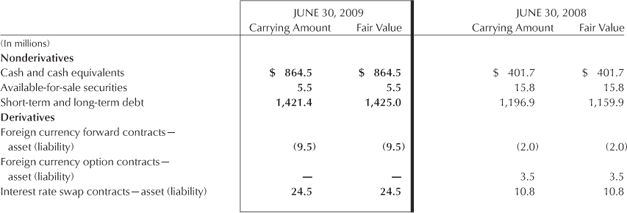|
|
NOTE 12 - FAIR VALUE MEASUREMENTS
The following table presents the Company's hierarchy for its financial assets and liabilities measured at fair value on a recurring basis as of June 30, 2009:
Fair Value of Financial Instruments Cash and cash equivalents-The carrying amount approximates fair value, primarily because of the short maturity of cash equivalent instruments. Available-For-Sale Securities - Available-for-sale securities are generally comprised of mutual funds and are valued using quoted market prices on an active exchange. Available-for-sale securities are included in investments in the accompanying consolidated balance sheets. Foreign Currency Forward and Option Contracts-The fair values of the Company's foreign currency forward and option contracts were valued using pricing models, with all significant inputs derived from or corroborated by observable market data such as yield curves, currency spot and forward rates and currency volatilities. Interest Rate Swap Contracts - The fair values of the Company's outstanding interest rate swap contracts were determined based on non-binding offers from the counterparties that are corroborated by observable market data. Short-term and long-term debt - The fair value of the Company's debt was estimated based on the current rates offered to the Company for debt with the same remaining maturities. To a lesser extent, debt also includes capital lease obligations for which the carrying amount approximates the fair value. The estimated fair values of the Company's financial instruments are as follows:
|

